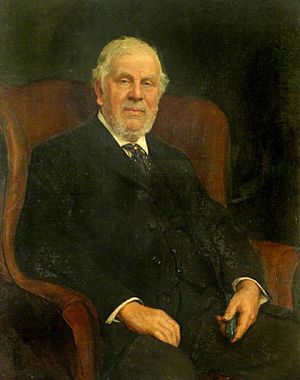William James Russell facts for kids
William James Russell (born 1830, died 1909) was an important English chemist. He was also a member of the Royal Society, which is a group of top scientists.
Contents
Who Was William James Russell?
William James Russell was born in a city called Gloucester, England, on May 20, 1830. His father, Thomas Rougher Russell, was a banker, and his mother was Mary Skey.
His Early Education
William went to school in Bristol and Birmingham. Later, in 1847, he went to University College, London. There, he studied chemistry with two well-known chemists, Thomas Graham and Alexander William Williamson.
His Journey in Science
After his studies in London, William worked at Owens College, Manchester from 1851 to 1853. He was a demonstrator, helping students learn chemistry. His teacher there was Edward Frankland.
William then traveled to Heidelberg University in Germany. He studied with another famous chemist, Robert Bunsen, and earned his Ph.D. (a high-level degree) in 1855.
In 1857, he became an assistant to his former teacher, Alexander William Williamson. Together, they worked on studying gases.
Teaching and Leadership Roles
William James Russell was a chemistry lecturer at St. Mary's Hospital, London, from 1868 to 1870. After that, he taught at St. Bartholomew's Hospital from 1870 to 1897. He also taught natural philosophy (which included science) at Bedford College, London, from 1860 to 1870. Later in his life, he became the chairman of the college's council.
William was a dedicated member of the Chemical Society for a long time. He even became its president from 1889 to 1891. In 1872, he was chosen as a Fellow of the Royal Society, which is a great honor for a scientist. He also helped start the Institute of Chemistry and was its president from 1894 to 1897.
William James Russell passed away in Ringwood on November 12, 1909.
What Were His Scientific Discoveries?
William Russell did a lot of important work in chemistry.
Studying Gases and Fog
He shared his findings about gases with the Chemical Society. He also wrote an article about "Gas Analysis" for a chemistry dictionary by Henry Watts in 1868.
One of his interesting studies was about how fog forms in London. He spent a lot of time researching this topic.
Other Important Research
William also worked on finding the exact weights of atoms for metals like cobalt and nickel. He wrote papers about how different materials, like wood, could affect a photographic plate in the dark. This was a very early look into how certain substances could interact with light-sensitive materials without light being present.
Images for kids



